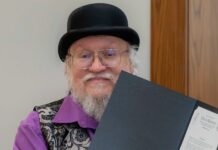If you’re looking for help trying to adapt a book for the big screen, consider studying the work of filmmaker Peter Jackson and his frequent co-writers, Fran Walsh and Philippa Boyens.
In the early aughts, Jackson and his loyal collective of New Zealand filmmakers did what had previously been thought impossible, turning J.R.R. Tolkien’s Lord of the Rings novels into a blockbuster series of award-winning films. Before that, the beloved fantasy novels had been deemed too dense, epic, and visually ambitious to put on screen, but Jackson and his fellow screenwriters were able to crack the code, assisted by a few deceptively simple principles.
They would later put those principles to work when adapting for the big screen the contemporary novel The Lovely Bones and Tolkien’s original Middle-earth adventure, The Hobbit — the two books represent very different source material, but nonetheless required similar disciplines. (Their 2005 version of King Kong was, of course, a movie remake, which brought its own interpretation challenges.) The Stone Street Studios crew’s latest film, Mortal Engines, is yet another book-to-screen adaptation, the first in a saga of four novels written by British author Philip Reeve, which envisions a wrecked future Earth in which cities are jacked up on massive platforms and tear through the countryside looking to consume smaller cities for parts.
And once again, Jackson and co. applied a few straightforward — but crucial rules — to the task.
“When you are adapting a book, by the time you’re adapting it, you’ve read it 10 or 15 times and you’ve read it in bits and pieces, and you’ve read it backward and forwards and frontwards,” Jackson explains to SYFY WIRE. “What I find is really important to remember is what that first experience of reading it was, and why did you like it? What was it that really made you enjoy it, on the first time that you read it?”
That should be self-evident, but once a screenwriter dives deep into a book — especially a fantasy novel with multiple volumes — they can sometimes get bogged down in the specific details of the fictional world, and subsequently focus on translating its many rules and endless ephemera to adaptation. This can be particularly tempting when a property has a rabid and very protective existing fan base, but in many cases, explanations and world-building have to be balanced with the enjoyment of the larger audience.
“In the end, you have to care about the characters that that action is happening to and that’s always a trick,” Boyens said. “And the trick in this one is that you’re already starting in a world that is quite complicated to understand, and at what point do you trust your audience and not overwrite it and not over-explain it and not overwhelm them with buckets of grievous exposition?”
There’s a fair amount of exposition in Mortal Engines, as would be expected of a movie set on a vastly different earth, set hundreds of years into the future. But there is also simplification; along with director Christian Rivers, the co-writers removed major plot points and cut some characters, which then changed the direction of subplots and even major storylines. The leading antagonist in Mortal Engines, Thaddeus Valentine, finds some kind of moral compass near the end the first novel, but he remains the top villain throughout the movie, where he is played by Hugo Weaving.
“it’s an interesting piece of storytelling and it would work really great if you were writing a TV series, but when he waivers, you just can’t do that on film,” Boyens explains, offering a prime example of the sacrifices you have to make for a movie, which so often requires simpler story arcs in big blockbusters.
It’s not a rule per se, but it should be noted, at least, that they were able to make that decision knowing that regardless, potential future installments of the franchise would still be viable. That’s because Reeve has long-since completed the book series, providing a roadmap that they could adjust along the way. To Jackson, that is the most crucial element.
“My idea of a nightmare as a filmmaker would be something like the Game of Thrones situation, where you’re adapting the books and the author’s still trying to figure out how he’s going to end it, and yet you’re having to make it without knowing what the ending is,” Jackson said. “From an insecurity point of view, that would sort of freak me out.”
Even though he didn’t have to worry about an author with a penchant for chronic procrastination, he did have to deal with some uncertainty. The circumstances in which Jackson and his team found themselves were a bit different than those of their past projects, when they had deals (at least eventually) to produce multiple installments in both The Lord of the Rings and The Hobbit franchises. This time around, there was no guarantee that there would be future installments, so they had to split the difference.
“We did [this movie] on the basis that we hope we’ll get to do the other three. We shape and to deal with decisions in Mortal Engines that we know are very important for the future stories,” Jackson said. “because there are certain aspects that, unless you’re familiar with the books, you won’t know what the significance of particular events or particular characters or things being referred to are. If we eventually get to film number three, then it’s going to all make sense.”
On The Hobbit and The Lord of the Rings, Jackson said, they treated each movie in the respective trilogies as an act in the three act structure, meaning that to get the full experience, the viewer had to watch all three. This time, they had to satisfy the audience in just over two hours, which demanded further practice of a discipline preached to them years ago.
“The movies have to be what you’d call a full meal,” Boyens said. “That’s what Alan Horn from Disney always said about The Hobbit. It should feel like you’ve had a full meal when you’ve seen the film, not like you have to wait for the next course, so to speak.”




















![[Book Review] The Blade Itself (The First Law Trilogy) by Joe Abercrombie](https://bendthekneegot.com/wp-content/uploads/2018/01/1516047103_maxresdefault-218x150.jpg)


















